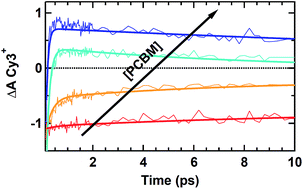Ultrafast charge transfer in solid-state films of pristine cyanine borate and blends with fullerene†
Abstract
Photoinduced electron transfer in light-absorbing materials is the first step towards charge separation and extraction in small molecule-based organic solar cells. The excited state dynamics of the cyanine dye cation Cy3 paired with a tetraphenylborate counter-anion (Cy3-B) was studied in pristine solid-state films of the dye and in blends with the electron acceptor material PCBM. Here we show that photoexcited Cy3-B in pure films undergoes intra-ion pair reductive quenching on the picosecond time scale, while in blends with PCBM sub-picosecond formation of the Cy3 oxidized species is observed upon electron injection from the dye excited state into the fullerene. Kinetic competition between light-induced electron- and hole transfer processes strongly depends on the PCBM content in the blends. A high PCBM loading produces a fully intermixed phase, where the cyanine oxidized states appear on ultrashort (<160 fs) time scales. Lower PCBM contents, in contrast, lead to a Cy3-B segregated phase on top of the intermixed phase and slower excited state quenching. These findings show that the phase morphology indeed controls to a large extent the efficiency of primary photoinduced charge separation, on which small molecule-based organic photovoltaic cells rely.


 Please wait while we load your content...
Please wait while we load your content...